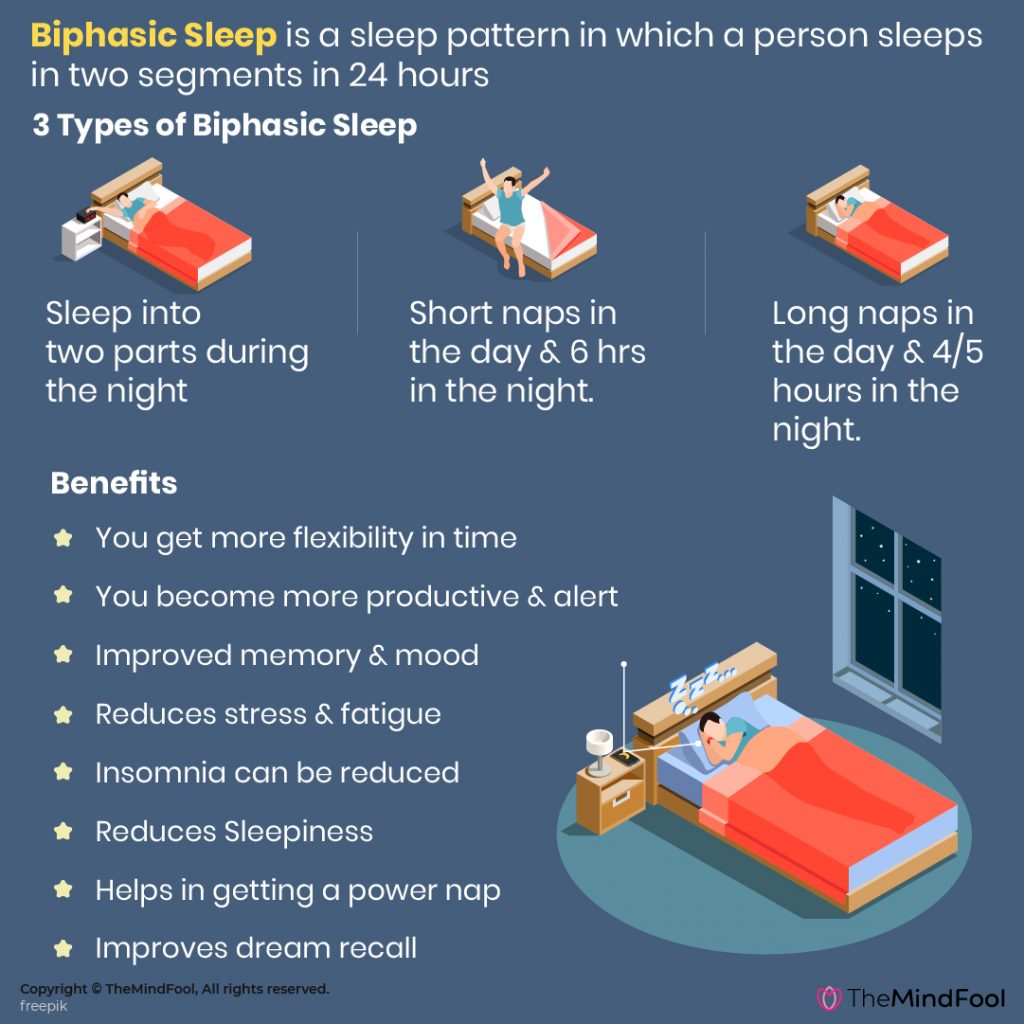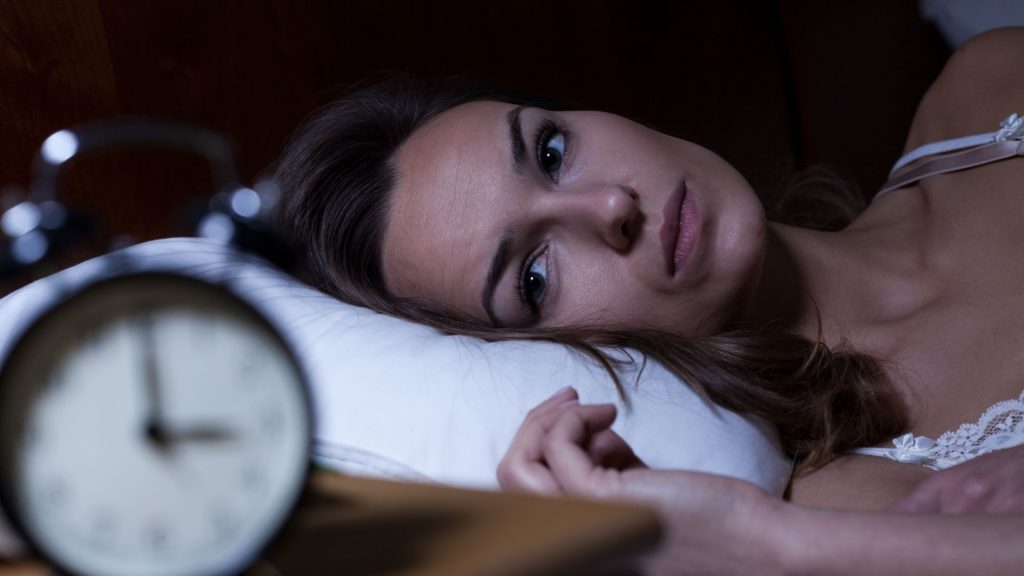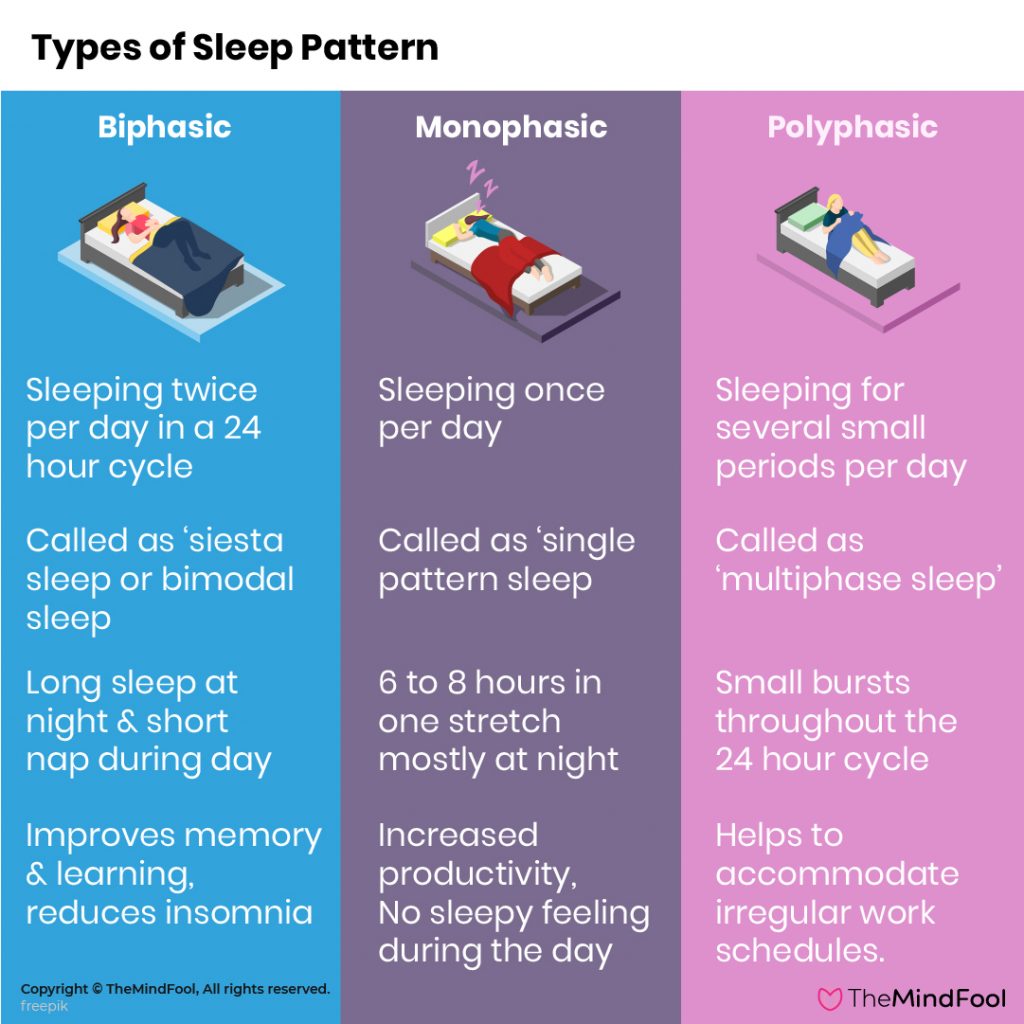
In this fast-paced life, we all want to be productive and extract the maximum out of our bodies and minds. Sleep is one such thing that we all want to balance with our day to day goals and tasks. It is almost considered lucky in today’s time when someone has normal sleep patterns for insomnia and other sleep disorders are on an all-time high. A good deep sleep ensures that we have enough energy to implement our day to day tasks and don’t feel stressed.
It also keeps our mind and body healthy. Did you know that there are types of sleep patterns that you can willingly opt for, for more productivity and energy? There is monophasic sleep, biphasic sleep, and polyphasic sleep. Let’s see how these are different from each other.
What is Biphasic Sleep?
Also known as bimodal, diphasic, or bifurcated sleep, biphasic sleep is a sleep pattern in which a person sleeps in two segments in 24 hours. Sometimes it is also referred to as segmented sleep. While this may sound like a new-age idea, the fact is that it is one of the most ancient types of sleep patterns.
Different parts of the world use different sleep patterns. Biphasic sleep is popular in the Southern parts of Europe. As per our age and the country we live in, we pursue a particular sleep pattern, however, for some people, it can be a deliberate decision to opt for biphasic sleep, and some it can completely come naturally.
Further, biphasic sleep can be of three types –
- People may pursue a sleep pattern in which they divide their sleep into two parts during the night. For instance, a person will sleep early in the night and then wake up for a few hours and then sleep again near the dawn. Some people may also sleep till late morning. In total, such people can finish about 8-9 hours of sleep.
- Short naps – Some people may prefer a biphasic sleep in which they take short naps during the day or siestas for about 1-2 hours and then sleep for about 6 hours straight during the night.
- Long naps – Some people also like to take long naps during the day time, which means they sleep for about 3 hours in the afternoon and sleep for about 5 hours straight during the night.
What is Monophasic Sleep?
Most people in the United States pursue monophasic sleep. Since most people also work during the day time, they don’t get time to nap in the afternoon even if they want to. The sleep pattern in which a person sleeps only one time in 24 hours is known as monophasic sleep.
Such people finish their sleep of 6-8 hours in one stretch, mostly during the night hours. It was the industrial revolution of the 18th and 19th centuries that pushed people to work during the day and have a monophasic sleep pattern. Recent research studies, however, show that for our bodies biphasic sleep pattern is more beneficial. We will look at all its benefits later in this article.
What is Polyphasic Sleep?
When the sleep patterns are broken into multiple parts during the day, it is known as polyphasic sleep. Polyphasic sleep can further be of different types and it depends on the person to person. However, there are two common types of these sleep patterns.
One, in which a person takes one long stretch of sleep of about 5-6 hours and then takes around 3-4 20 minutes nap during the day. Another one is where a person sleeps only for about 3 hours in one stretch and takes 4-5 naps during the day. Some people finish their 8 hours of total sleep by dividing sleep time into multiple parts and some people just thrive on small naps to increase productivity.
TIP
It should be noted that some people have a type of polyphasic sleep pattern because of insomnia, stress, sleep deprivation or any other sleep disorder while some other people have it naturally. It is best to consult a doctor to recognize your sleep pattern and then work on the one that you want to achieve.
History of Biphasic Sleep
A famous historian and sleep pattern expert, Roger Ekirch, has presented more than 500 references to prove that before the industrial revolution, segmented sleep was quite common. He has written a book called At Day’s Close: Night in Times Past in which he argues that till the 17th century, people used to sleep in two phases. Between these phases there would be wakefulness of about one hour to perform various activities such as thinking about dreams, staying in bed, talking to their spouse, smoking, having sex, etc.
Another sleep scientist, Thomas Wehr, performed a study in 1992 which said: “In short photoperiods, human sleep is biphasic”. For this study, he put 8 healthy people in a room for 14 hours every day for a month. At first, all these people slept for straight long hours but gradually, they started sleeping for 4 hours straight and then woke up for about 2 hours in the middle and then slept again.
There is a lot of historical evidence to prove that biphasic sleep is an ancient kind of sleep pattern. Even literature from the 14th century shows evidence of how it was common for people to sleep in segments. In The Canterbury Tales, one character has been recorded to say that she would return to bed after her first sleep. It had an explicit mention of “first sleep” and “second sleep”. Some scientists also suggest that due to the invention of light, people shifted from biphasic sleep to monophasic sleep pattern.
What Science says for Biphasic Sleep?
A study by the School of Psychology, Flinders University, Adelaide, says napping can be good for cognitive functioning. It further says that naps also reduce sleepiness. In another journal published in 2009, Brock University’s professor says, naps improve performance in areas such as logical reasoning, symbol recognition and reaction time.
However, there are also many sleep experts, psychiatrists, and doctors who suggest a straight and deep sleep for better and effective functioning. Such studies and reports can be contradictory, however, most of them give us a hint that there are no disadvantages of napping if you finish an overall 7-8 hours of sleep. It is also certain that by changing sleep patterns, we change the flow of sleep hormone, melatonin, and circadian rhythms.

Biphasic Sleep Cycle
The biphasic sleep cycle works with two sleep schedules per day. The most common one is a long sleep during the night, of about 5 to 7 hours, with a shorter rest or nap of about 1 to 2 hours during mid-day. This sleep is generally known as Siesta sleep or post lunch dip.
Here, the individual divides the sleep schedule in two separate cycles according to their biological requirements and sleep wake rhythms.
As the biphasic sleep cycle works in shifts, both the sleep sessions may get completed at night with 2 to 3 hours of wakefulness. Another cycle can be a long night nap and a short one in the daytime. The length of the naps varies according to individual preference. A biphasic sleep can yield a total of 8 hour sleep.
Biphasic sleep schedule
Biphasic sleep schedule is a popular sleep pattern followed in medieval times in pre industrial Europe. The biphasic sleep schedule consists of two parts:
1. Segmented sleep
Segmented sleeping started in places where artificial lighting was not there in medieval times. It consisted of two core sleep patterns with a waking time in between. Usually, each block is 3-5 hours to 4 hours in duration. The core gap between the segmented sleep is 2.5 hours approximately.
2. Siesta sleep
The Siesta sleep schedule consists of two core sleep patterns. One long core during the night and a single short cycle in the day. Though siestas are common in many parts of the world, it is typically associated with the Spanish culture. The logic that worked behind the sleep pattern is that our circadian rhythm remains low during afternoon; around 1 pm to 3 pm.
So, most people in western culture find this time as the least productive one. Thus, this time is considered as an ideal moment to reduce tiredness and take rest. This sleep schedule is a short nap that can range from 30 minutes to 90 minutes.
Biphasic sleep schedule example
The two most common examples of biphasic sleep schedules can be represented with the help of segmented time distribution. Let’s see how
1. In Two nightly sleeps; a person goes to bed within a few hours of sunset. The first sleep lasts for 3 to 5 hours. Then, they wake up for a period of half an hour to 2 hours. During this time; these people can carry on with some routine work according to their requirements. The second sleep starts towards the start of dawn and may last till 6am to 7am in the morning. This period lasts from 2 to 4 hours, depending upon individual preference. A typical segmented sleep of this type may look like –
- 8:00 pm – first sleep begins
- 1am – wake up /mild activity/ sitting idle
- 4am – second sleep starts
- 6:30 – 7:00 am – waking up again to start a new day.
2. In Siesta sleep, a tiny nap is taken for some short rest. The main purpose of this sleep is to reduce physical tiredness and get back to work with renewed energy. The siesta sleep occurs at night with a long duration of 5 to 6 hours at a stretch. Then, next morning, around midday the person goes to sleep for 1 to 2 hours. This sleep also comprises 8 to 9 hours of total sleep. The schedule of siesta sleep looks like –
- 11 pm – begin first sleep
- 5am – 6am – wake up
- 2pm – short nap post lunch
- 3:30pm to 4pm – wake up
Here, the total sleep is bifurcated into a long chunk at night and a short segment around mid-day with a long sizable wake up interval between them.
NOTE
There is no best biphasic sleep schedule that may work well for all. What works well for you may not be suitable for the other person. It depends upon daily demands of the family, work, and social life. You need to develop a standard pattern for yourself that suits your requirements.
Benefits of Biphasic Sleep
People who have adopted biphasic sleep patterns, have recorded their statements and have spoken about the benefits of it. Some of the benefits involve –
1. Flexibility

Dividing your sleep into two parts can make your entire day’s routine much more flexible. You may get more time to perform activities.
2. More alertness

When we sleep for a long hour on a stretch, we spend the rest of the hours doing tiring and exhausting activities. Working for so many hours constantly decreases our productivity and alertness. It puts us into lethargy. Thus, taking a nap in the middle can revive our energy back and make us more alert.
3. More productivity

When we work constantly for long hours our brain stops working efficiently after a certain period. Some people also experience brain freeze or brain block, Creative people or writers may run out of ideas. While taking a break for coffee or tea helps but sleeping for a small interval rejuvenates your body and almost hits a restart button, making you more productive.
4. Improved memory and mood

A lot of people have claimed that after they started sleeping in segments, their memory has improved. They remember things better. People have also shown improvement in their mood patterns. They feel happier and satisfied.
5. Reduce stress and fatigue

Most benefits of napping are also benefits of biphasic sleep. People who have segmented sleep habits or habit of napping tackle stress and fatigue better. They make fewer errors at work. Their problem-solving abilities, cognitive function and ability to learn new things increase manifold.
6. Flexible Scheduling

Biphasic sleep is a segmented sleep pattern. The individual can adapt a flexible scheduling in terms of when and how to have short periods of rests. This helps to compensate for the lack of sleep at night during mid-day in the post lunch session. So, according to convenience the person can take short rests in between waking hours.
7. Insomnia can be reduced

For individuals who suffer from insomnia or lack of a good night’s sleep can adapt to a biphasic sleep schedule. This is helpful because they can complete their 8 hours of minimum sleep by sleeping twice a day and feel refreshed.
8. Improves dream recall

Research findings suggest that people who follow biphasic sleep schedules can have improved dream recall. They are able to say what they were thinking while asleep. This gives cue their subconscious mind and its thought content.
9. Power nap

Biphasic sleep helps in getting a power nap. Short periods of rest taken in between daily working hours can have health benefits. It refreshes the mind and energizes the body. Your tired body can get some backup power to start working again.
10. Reduces Sleepiness

People who sleep twice in a 24 hour cycle feel less sleepy and tired than Monophasic sleep lovers. Naps keep you awake and mindful throughout the day. It keeps the mind alert and aids thinking and memory power.
Difference between Biphasic, Monophasic, and Polyphasic sleep
There are some subtle differences between these three forms of sleep schedules.
| Biphasic | Monophasic | Polyphasic |
| The individual sleeps twice per day in a 24 hour cycle. | The individual sleeps once per day. | The individual sleeps for several small periods per day. |
| It is also called siesta sleep or bimodal sleep. | It is also called a single pattern sleep. | It is also called multiphase sleep. |
| Biphasic sleep is a segmented sleep where 6 to 8 hours sleep is divided in a long sleep at night and short nap during mid day. | People sleep for 6 to 8 hours in one stretch mostly at night. | Polyphasic sleep happens in small bursts throughout the 24 hour cycle; instead of sleep happening only at night. |
| It is commonly found in Europe, India, Latin America and the Mediterranean. | Popular in USA and Caribbean Islands | It is popular across the globe in different Urban Communities. |
| Biphasic sleep improves memory and learning. It is a good way to reduce insomnia. | Monophasic sleep allows opportunity for increased productivity as the individual completes 7 to 8 hours of uninterrupted sleep at a stretch and hardly feels sleepy later during waking hours. | Polyphasic sleep helps individuals who need to accommodate irregular work schedules. |

What to keep in mind?
Since there is still research going on on the benefits and drawbacks of segmented sleep patterns, you must not make a decision in a hurry and voluntarily change your sleep-wake cycle. This decision should be taken with a lot of precautions.
Different people have different types of sleep patterns. You must not try to compare yourself with any other person. First, you need to check if your current sleeping pattern is working for you or not. If your sleeping pattern is working out well for you then you don’t have to worry about changing it. Here are a few things you can notice in yourself –
- Stress level
- Temperament
- Focus abilities
- Concentration power
- Energy levels
- Irregular sleep patterns
Further, it is also important to note that if you have depression, PTSD, BPD or any other disorder, you shouldn’t opt for biphasic sleep habits without consulting your doctor. In such cases, doctors mostly suggest sleeping at night for long hours. Some people wake up in the middle of the night because of insomnia and sleep disorders. Do not misunderstand any such disorder with a natural biphasic sleeping schedule.
Closing thoughts
If you are someone who works the whole day at an office place then it may not be possible for you to take naps during the day. However, you can try segmenting your sleep into two parts, divided by one hour break. You can try to utilize that one hour for some activities that you like to do.
Make sure that when you do such an experiment, you keep your phone and other disturbing elements away since they can disturb your segmented sleep and make you more agitated and tired.
Eventually, what’s really important is for the body and mind to feel fit and healthy. While biphasic sleep can be beneficial for you, you have to ensure that you also implement other methods such as healthy eating, exercising, etc to keep your sleeping pattern regular and consistent.
A Psychologist with a master's degree in Psychology, a former school psychologist, and a teacher by profession Chandrani loves to live life simply and happily. She is an avid reader and a keen observer. Writing has always been a passion for her, since her school days. It helps to de-stress and keeps her mentally agile. Pursuing a career in writing was a chance occurrence when she started to pen down her thoughts and experiences for a few childcare and parenting websites. Her lovable niche includes mental health, parenting, childcare, and self-improvement. She is here to share her thoughts and experiences and enrich the lives of few if not many.
